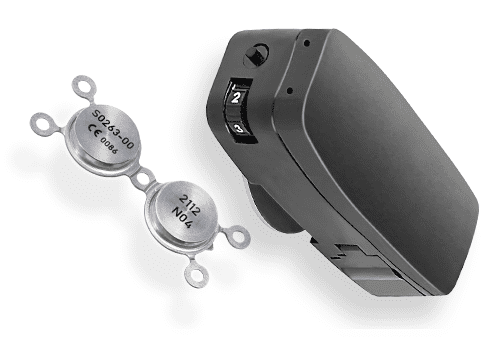 Medtronic, Dublin, Ireland, the world’s third largest medical device manufacturer, has purchased bone-anchored hearing implant manufacturer Sophono, Boulder, Colo. Medtronic says that the purchase of Sophono enables its Ear Nose and Throat (ENT) business to continue its focus on novel therapies and innovative technology solutions and supports Medtronic’s therapy innovation strategy. Terms of the deal were not disclosed.
Medtronic, Dublin, Ireland, the world’s third largest medical device manufacturer, has purchased bone-anchored hearing implant manufacturer Sophono, Boulder, Colo. Medtronic says that the purchase of Sophono enables its Ear Nose and Throat (ENT) business to continue its focus on novel therapies and innovative technology solutions and supports Medtronic’s therapy innovation strategy. Terms of the deal were not disclosed.
“As the leader in ENT products and therapies, Medtronic is proud to add Sophono’s minimally invasive, low profile hearing implants to our extensive otologic portfolio,” said Mark Fletcher, senior vice president and president of the Surgical Technologies business, which is part of the $6.5 billion Restorative Therapies Group at Medtronic. “This acquisition enables us to partner with more surgeons worldwide to help more patients experience better hearing.”
Sophono, founded in 2009, manufactures an abutment-free, implantable, magnetic bone conduction hearing system. The device received FDA clearance in June 2011. The company’s Transcutaneous Energy Transfer (TET™) Technology reportedly enables the maximum transfer of energy through the skin to a specially-designed magnetic implant without drilling a hole in the patient’s skull and installing a screw that pokes out through the skin on the side of the head. It is reportedly the only transcutaneous hearing system on the market that is optimized for sound transmission through the skin.
Medtronic will include revenue from the Sophono product line as part of the Surgical Technologies division within the Restorative Therapies Group segment. The transaction is expected to meet Medtronic’s long-term financial metrics for acquisitions, and the annualized earnings impact of this acquisition “is not expected to be material,” says the company.
This is not Medtronic’s first time in the hearing implant market. In the 1990s, it introduced its Xomed Audiant under-the-skin bone conduction hearing aid with a “bone conductor-like transducer,” but the product reportedly failed due to post-surgical complications. Sophono’s company chairman, Markus Haller, is a former Medtronic executive who, along with investors in 2008, acquired the transcutaneous bone conduction hearing system originally developed by German Inventor Dr Ralf Siegert some 4 years earlier.
Hearing Review reported that Sophono received $7 million in August 2012 in growth capital financing led by Wexford Capital LP, Greenwich, Conn. In August 2014, Sophono announced that the company had entered into a global partnership with Hangzhou Nurotron Biotechnology, Hangzhou, China, a rapidly expanding manufacturer of the cochlear implant systems and BTE cochlear speech processors.
Sophono implants are currently available in 42 countries and have been implanted in more than 4,000 patients. They are intended for patients 5 years and older with single-sided deafness (SSD) or conductive, mixed hearing loss. The slim-profile implant and magnetic, transcutaneous Alpha 2 MPO™ sound processor enables ENTs and audiologists to restore patient hearing through a simple, minimally invasive procedure. The Alpha 2 MPO allows patients to achieve improved hearing without the potential skin-related complications associated with current abutment-based percutaneous systems.
Studies have shown the use of the Sophono device has resulted in significant hearing and speech recognition improvement in patients with conductive, mixed hearing loss or SSD. Preliminary results from a multi-device clinical study presented at the 2015 Ultimate Colorado Midwinter Meeting in Vail, Colo, demonstrated better Alpha 2 MPO performance at higher sound frequencies than currently available percutaneous and transcutaneous options, according to Medtronics.
Medtronic is the world’s third largest medical device manufacturer with a market capitalization of over $100 billion and the company employs 85,000 people, including 5,800 scientists and engineers, in 160 countries. The company most recently received a lot of attention when it moved its headquarters from Minneapolis to Dublin in a wave of corporate relocations attributed to tax inversion.






